40 Gardening Tools List With Pictures and Their Uses
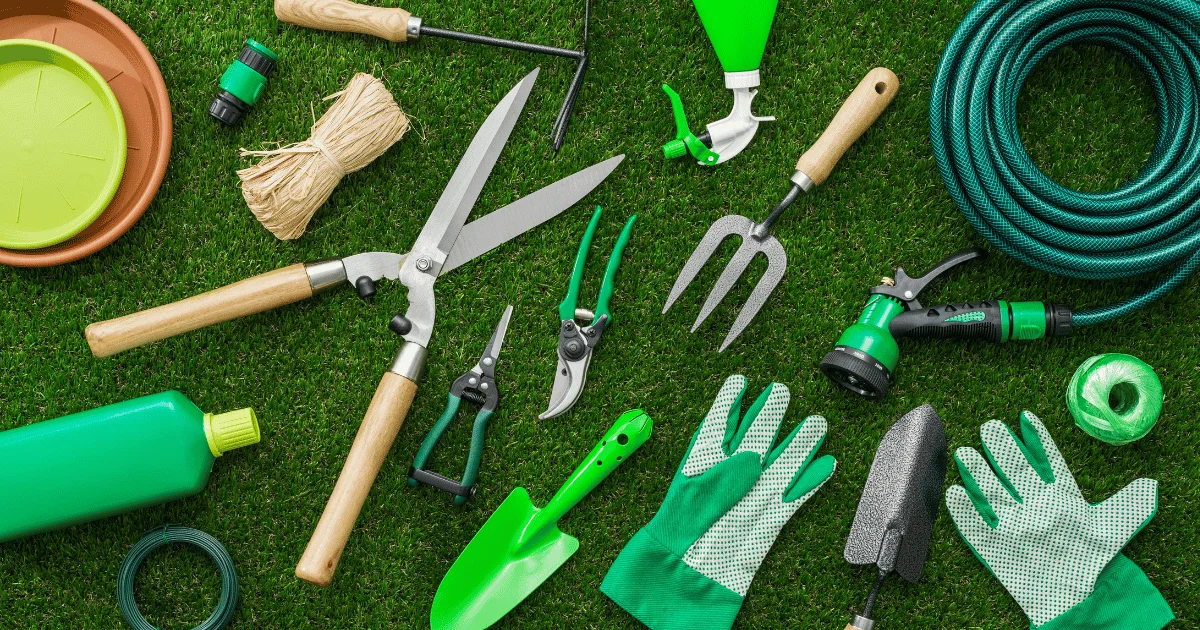
As I share this article with you, I’m bringing together my own experiences from the garden, distilled into valuable insights for beginners. This guide is not just a list of tools with names and uses; it’s a pathway to success for those embarking on their gardening journey.
Each tool mentioned has been a part of my journey, contributing to the successes in my garden. By understanding the role and proper use of these tools, you’re equipping yourself with more than just equipment – you’re gaining allies in the beautiful yet challenging adventure of gardening.
Whether you’re nurturing a small balcony space or a sprawling backyard, these insights aim to lay a strong foundation for your gardening endeavors. Let this guide be your companion as you step into the rewarding world of gardening, helping you grow not just plants, but also your skills and passion for this timeless art.
Note: As an Amazon Associate, I earn from qualifying purchases at no extra cost to you.
Here’s a List of 40 Gardening Tools With Pictures and Their Uses:
For soil preparation in gardening, you would typically need the following tools:
1. Spade
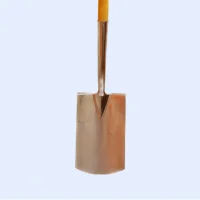
A spade is used for digging and breaking up earth.
How to Use: Keep a straight back and lift with your legs, ensuring a firm grip.
Example: When edging garden beds, maintain a steady pace and take breaks to prevent overexertion.
See Also: Can You Grow Peonies Indoors?
2. Shovel
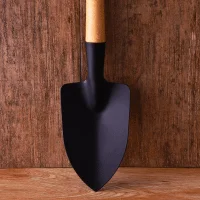
Shovels are used for scooping loose material.
How to Use: Keep your back straight and lift with your legs to prevent back strain.
Example: When digging, pace yourself to prevent fatigue and ensure the area is clear of underground utilities.
3. Garden Fork
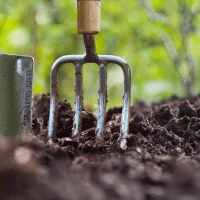
A garden fork is useful for turning soil and breaking up clumps.
How to Use: Keep your back straight and bend your knees when lifting to prevent back strain.
Example: When turning soil, keep a firm grip on the handle and lift with your legs, not your back.
4. Hoe
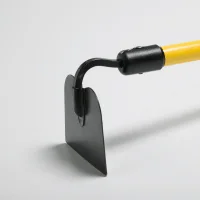
Hoes are used for weeding and soil preparation.
How to Use: Use with a proper stance to prevent back strain, and ensure the area is clear of rocks and debris.
Example: When weeding, use a chopping motion without overextending to maintain balance.
5. Rake
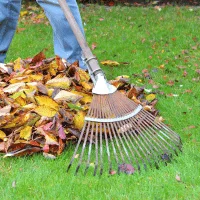
Rakes are used for leveling soil and collecting leaves or debris.
How to Use: Maintain a straight back and avoid overreaching to prevent back strain.
Example: When raking leaves, use a comfortable grip and short, even strokes to collect debris without overexerting.
6. Cultivator
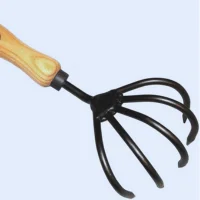
This tool is used for easily loosening the soil.
How to Use: Use with a proper grip and stance to prevent back or wrist strain.
Example: While loosening soil, keep a steady pace and take breaks to prevent fatigue.
7. Tiller
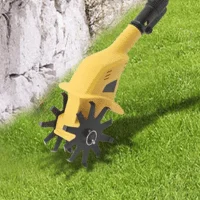
Tillers are used to prepare large areas of soil for planting.
How to Use: Clear the area of rocks and debris, and keep others at a safe distance to prevent injury.
Example: When preparing a new garden bed, operate the tiller in a steady, controlled manner to prevent unexpected jolts.
8. Aerator
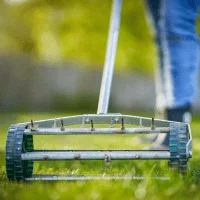
Aerators are used to perforate the soil to allow air, water, and nutrients to reach the roots.
How to Use: Wear sturdy boots and ensure the area is free of stones or debris.
Example: When using a manual aerator, step down firmly to penetrate the soil, avoiding rocky areas to prevent bouncing and potential injury.
9. Auger
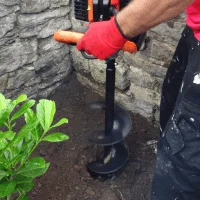
Used for making holes in the ground for planting.
How to Use: Wear gloves and eye protection, and ensure there are no underground utilities before drilling.
Example: When using a power auger to dig holes for a fence, keep a firm grip to control the tool if it hits a rock.
10. Broadfork (U-fork or Grelinette)
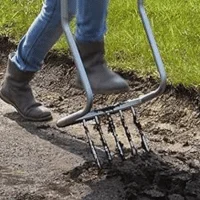
Used to break up densely packed soil to improve aeration and drainage.
How to Use: Step down firmly on the crossbar, keeping your balance to prevent falls.
Example: Use the broadfork to aerate a bed for new planting, ensuring the area is clear of debris.
11. Core Aerator and Drum Aerators
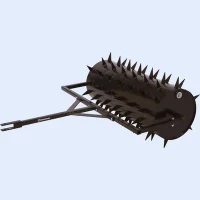
Penetrate the earth to reduce soil compaction by creating channels that allow air, water, and nutrients to penetrate the soil.
How to Use: Wear sturdy boots and ensure the area is free of stones or debris.
Example: When using a manual aerator, step down firmly to penetrate the soil, avoiding rocky areas to prevent bouncing and potential injury.
When it comes to planting, there are several essential gardening tools that you should consider having. Here’s a list of some of the most important ones:
12. Dibber
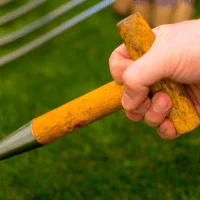
A dibber is used for making holes in the soil for seeds or seedlings.
How to Use: Hold firmly and push into the soil with even pressure to avoid slips.
Example: When making holes for seeds, ensure the soil is moist enough to prevent extra force and potential wrist strain.
13. Bulb Planter
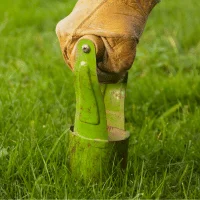
This tool is specifically designed to make the correct-sized hole for planting bulbs and other plants.
How to Use: Use both hands to apply pressure evenly and avoid twisting your wrist or back.
Example: While planting bulbs, ensure the area is clear of rocks to prevent sudden jolts.
14. Seed Drill
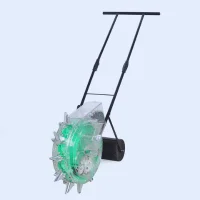
A seed drill is used for planting seeds at precise depths and intervals.
How to Use: Ensure the area is clear of debris and rocks to prevent jamming or unexpected jolts.
Example: Calibrate the seed drill accurately to ensure seeds are sown at the correct depth and spacing, reducing the need for overexertion.
For professional garden maintenance, a more comprehensive set of tools is required to handle a variety of tasks efficiently and effectively. Here’s a list of essential professional gardening tools for maintenance:
15. Pruner & Shears
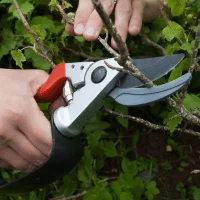
Pruners are used for trimming and shaping plants.
How to Use: Keep the pruner locked when not in use, and ensure a comfortable grip to prevent hand strain.
Example: When pruning, cut at a slight angle away from buds to promote healthy growth while maintaining a steady hand.
Related: How to Prune Creeping Phlox in Winter
16. Lopper
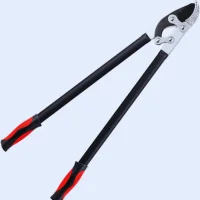
Loppers are like pruners but have longer handles for reaching higher branches.
How to Use: Keep others at a safe distance when cutting, and ensure the blades are sharp to reduce the required force.
Example: When trimming branches, position the lopper so the branch is in the jaw’s groove to get a clean cut.
17. Weeder
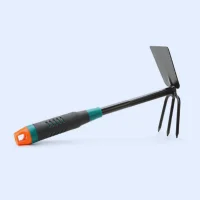
Weeders are used for removing weeds from the ground.
How to Use: Use with a proper stance to prevent back strain, and keep a firm grip to prevent slips.
How to Use: When removing dandelions, use a weeder to lever the plants out without overexerting.
18. Sprayer
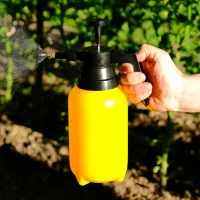
Sprayers are used for applying pesticides, herbicides, or fertilizers.
How to Use: Follow the manufacturer’s instructions for mixing and applying chemicals, and wear protective gear to prevent exposure.
Example: When spraying pesticides, ensure the nozzle is directed away from you to prevent chemical exposure.
19. Garden Hose or Watering Can
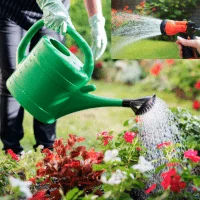
For watering plants.
How to Use: Use a can with a comfortable grip and manageable weight to prevent strain.
Example: Water plants at the base to prevent splashing and potential slipping hazards.
20. Garden Scissors
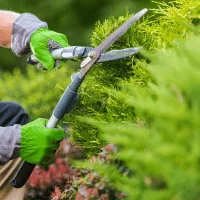
These are used for a variety of cutting tasks in the garden.
How to Use: Keep them closed and locked when not in use, and always cut away from your body.
Example: When deadheading flowers, ensure a steady grip to prevent slips and accidental cuts.
You May Like: Best Plants for Shallow Pots
21. Garden Knife
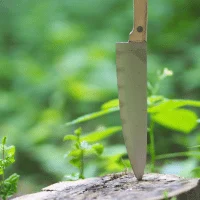
A multi-purpose tool used for various cutting tasks.
How to Use: Handle with care; always cut away from your body and keep the blade sheathed when not in use.
Example: While dividing plants or cutting twine, ensure the blade is sharp to require less force and prevent slips.
22. Lawn Mower
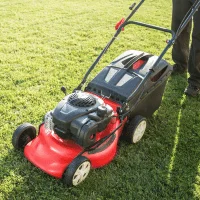
Used for cutting grass to an even height.
How to Use: Ensure the area is clear of debris, and children and pets are at a safe distance before starting.
Example: Mow in a pattern to ensure you cover the entire lawn without overlapping too much, reducing the risk of tripping or slipping.
23. Backpack Sprayer
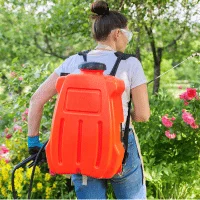
Used for treating plants with insecticides and pesticides.
How to Use: Use a properly fitted sprayer to avoid back strain, and follow chemical instructions for mixing and spraying.
Example: When spraying pesticides, wear protective clothing and a face mask to avoid inhalation or skin contact.
24. Broadcast Sprayer
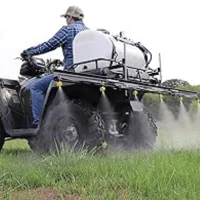
Used for spraying insecticides and pesticides over a large area.
How to Use: Follow the manufacturer’s instructions for use, and wear protective clothing when spraying chemicals.
Example: Use the broadcast sprayer to cover large lawn areas with fertilizer, ensuring the nozzle is properly adjusted to avoid overspray.
25. String Trimmer (Weed Whacker, Weed Eater)
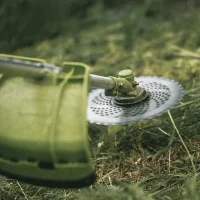
Used to cut grass and other soft objects.
How to Use: Equip protective gear, clear the area of people and debris, and maintain a firm grip and balanced stance while operating.
Example: Edge along pathways or flower beds at a steady pace, starting at a lower speed to ensure control and gradually adjusting as needed.
26. Billhook Saw
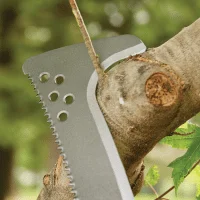
Used for trimming shoots and stems, cutting vines, severing roots, and sawing branches.
How to Use: Ensure a firm grip, wear protective gloves to prevent cuts, and clear the surrounding area of others before using.
Example: When trimming shoots or cutting vines, use controlled, steady motions to avoid slips and ensure precise cuts.
27. Irrigation Sprinkler
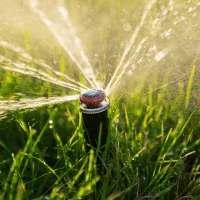
They are used for cooling, irrigating plants, lawns, and landscapes, or controlling airborne dust.
How to Use: Set up the sprinkler in a level area to ensure even water distribution, and ensure the area is clear of electrical cords or outlets to prevent water damage or electrical hazards.
Example: Position the sprinkler to cover the desired watering area, adjusting the spray pattern and distance as needed to provide adequate coverage without over-watering.
28. Compost Bin
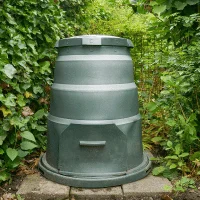
Holds organic materials for decomposition into compost.
How to Use: Ensure the lid is securely fastened to prevent wildlife access; avoid leaning into the bin to prevent falls.
Example: When turning compost, use a proper compost fork and avoid overreaching to prevent back strain.
See Also: Peony Growing Stages Timelapse (Pictures)
29. Compost Fork (Manure Fork or Mulch Fork)
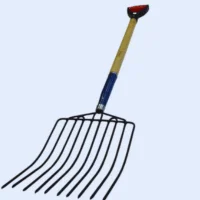
Used for loosening, aerating, and transplanting compost or manure, as well as moving bulk organic material.
How to Use: Keep a straight back and bend your knees when lifting; avoid overloading the fork.
Example: Turn compost regularly, but ensure the load is manageable to prevent back strain.
30. Edging Shears
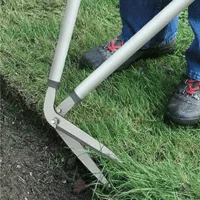
Used for cutting the grass precisely along walkways or around garden beds, and crafting a distinct boundary between the lawn and another ground surface.
How to Use: Use with both hands and keep others at a safe distance to avoid injury.
Example: While trimming hedges, ensure a comfortable stance and cut in smooth, controlled motions to prevent strain.
31. Flat Rake (Level Head Rake)
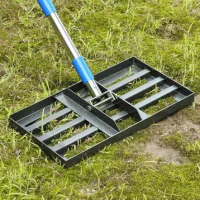
Used for clearing debris, breaking down clumpy soil, and spreading fertilizer or compost.
How to Use: Maintain a straight back bend your knees slightly when using the rake, and ensure the area is clear of others to prevent injury.
Example: Use the flat rake to spread compost evenly across a garden bed, using smooth and controlled motions to prevent clumps and ensure a level surface.
Harvesting your garden requires a different set of tools, specifically designed to help you collect fruits, vegetables, and other plants efficiently and without damaging them. Here’s a list of essential gardening tools for harvesting:
32. Harvesting Knife
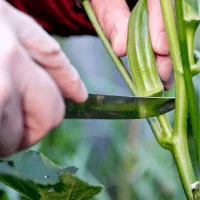
Used for cutting fruit, vegetables, and other plants.
How to Use: Cut away from your body and ensure the blade is sharp to require less force.
Example: Harvesting zucchini, ensure a firm grip and steady hand to prevent slips.
33. Budding Knife
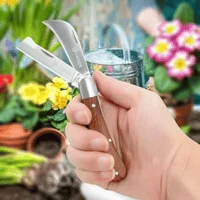
Used for delicate budding tasks and grafting.
How to Use: Handle with care to avoid cuts; store in a sheath or safe place when not in use.
Example: When grafting, cut away from your body and ensure hands are steady to prevent slips.
You May Like: What Vegetables Can Grow in 4 Hours of Sun?
34. Fruit Picker
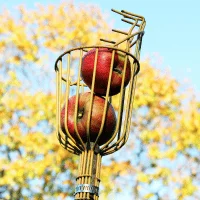
A tool used for reaching and harvesting fruit from tall trees.
How to Use: Use with a steady stance, especially on uneven ground, to prevent falls.
Example: While picking apples, ensure the area below is clear to prevent tripping over fallen fruit.
35. Secateurs
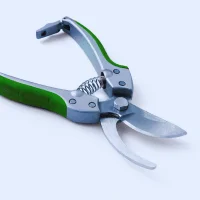
Another type of cutting tool used for harvesting and pruning.
How to Use: Keep them locked when not in use, and maintain a firm grip while cutting to prevent slips.
Example: When pruning, cut at a slight angle to promote healthy growth, ensuring your hands are steady to avoid accidental cuts.
Miscellaneous gardening tools encompass a wide range of items that serve various specialized or supportive functions in gardening. These tools can enhance the gardening experience, making certain tasks easier, more efficient, or more precise. Here’s a list of some miscellaneous gardening tools:
36. Wheelbarrow
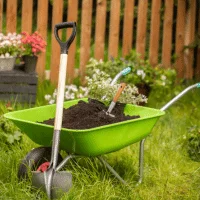
For transporting soil, compost, and garden waste.
How to Use: Load evenly to maintain balance, and avoid overloading to prevent tipping.
Example: When transporting soil, ensure a steady grip on the handles and a clear path to prevent spills and trips.
37. Gloves
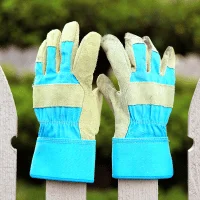
Protect your hands while gardening.
How to Use: Wear gloves that fit well to protect your hands from thorns, sharp tools, and harsh chemicals.
Example: Use gloves when pruning roses to prevent thorn pricks.
38. Kneeler or Knee Pads
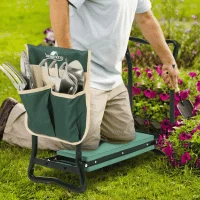
Provides cushioning for your knees while working close to the ground.
How to Use: Ensure they fit well and are securely fastened to prevent falls.
Example: Use kneelers when planting seedlings to reduce knee strain.
Must Read: What Fruits Grow in 30 Days
39. Garden Twine
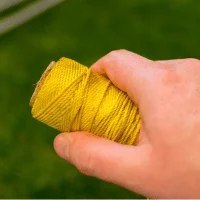
Useful for training plants and other tying tasks.
How to Use: Keep it neatly rolled to prevent tripping hazards and cut off the required length instead of pulling it directly from the roll.
Example: When tying up tomatoes, cut a length of twine first to avoid entanglement.
40. Apex Shed
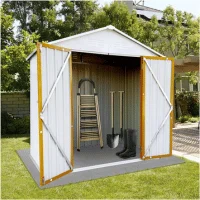
A sheltered outdoor workspace for gardening projects and for storing garden equipment.
How to Use: Ensure the shed is securely anchored and the door is properly latched to prevent accidents.
Example: Store sharp tools like saws or pruners on higher shelves or in locked cabinets to prevent access by children.
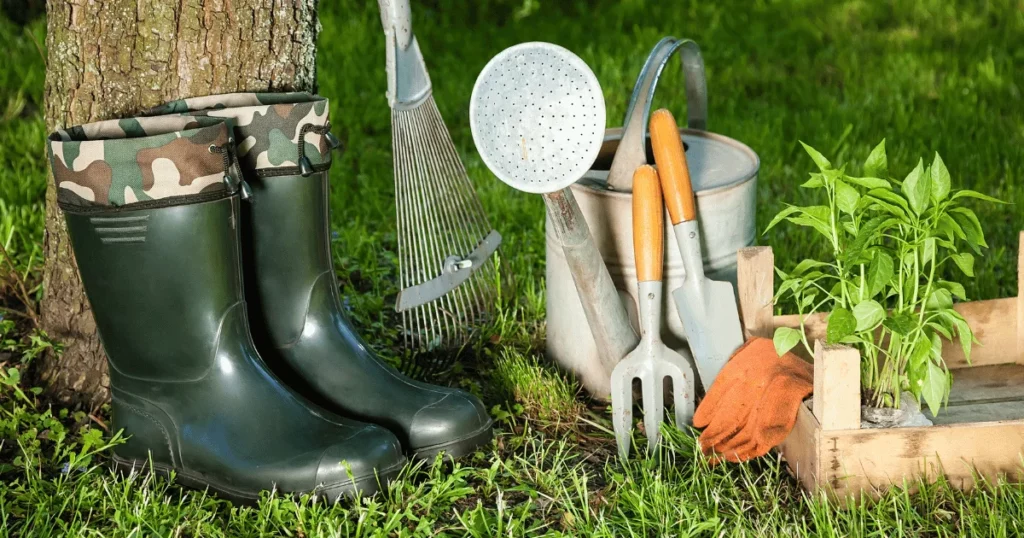
FAQs
Who makes the best quality garden tools?
Several reputable brands are recognized for producing high-quality garden tools, including Bulldog, Spear and Jackson, Fiskars, Sneeboer & Zn, and Corona. Sneeboer is noted for desirable manual tools like garden rakes, while Fiskars is praised for its durable shovels.
What metal is best for garden tools?
Garden tools crafted from high-carbon steel are exemplary for tasks like digging, planting, snipping, and weeding. This alloy, a blend of iron and minimal carbon, is forged under intense heat conditions. Post forging, these materials undergo a reheating and tempering process, where the iron amalgamates with carbon granules, culminating in a robust steel ideal for enduring the rigors of gardening tasks.
Are copper tools better than stone tools?
Copper revolutionized agricultural practices due to its durability. Unlike stone tools, copper hoes and similar implements exhibited lesser tendencies to break, making them more dependable. Moreover, copper sickles retained their sharpness longer, while stone counterparts tended to chip after extensive usage, enhancing efficiency in farming tasks.
Should you oil garden tools?
Yes, oiling garden tools is advisable. It prevents rust, keeps mechanisms smooth, and extends tool longevity. A light coat of oil post-cleaning shields against moisture and ensures readiness for future use.
Also Read: China Doll Plant Care Tips, Propagation, Benefits, Problems
Final Words
The gardening tools highlighted in this article are indispensable for aspiring and seasoned gardeners alike. Each tool, with its unique functionality, simplifies specific gardening tasks, making the practice more enjoyable and fruitful. The accompanying images and descriptions provide a clear understanding, aiding especially the novices in embarking on their gardening endeavors.
Investing in these tools equips one with the requisite resources to nurture a vibrant garden. With the right tools in hand, every gardener is well-poised to explore the myriad possibilities that gardening presents, fostering a verdant, flourishing outdoor space.
Did you find our guide on professional gardening tools helpful? If we missed any of your favorite tools, please share your thoughts in the comments below! Your input is invaluable to us and fellow garden enthusiasts. 🌼🌱
All images courtesy of Canva.
